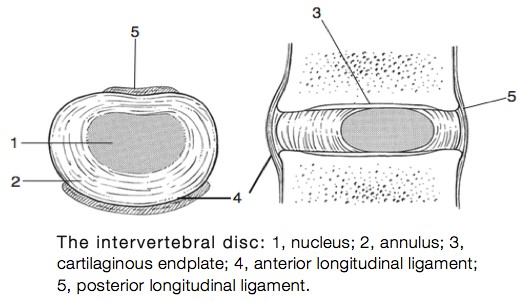
If you are one of 31 million Americans experiencing back pain, neck pain, or low back pain, a "slipped" disc (1) or herniated disc may be the cause.
But what exactly is a herniated disc, and how does it become injured?
The spine consists of 24 blocky bones (vertebra) stacked on top of each other in a flexible column that allows our body to move. Between each vertebra sits a soft, rubbery cushion made of cartilaginous fibers and hydrated proteins known as an intervertebral disc (2).

(picture from Google images)
Intervertebral discs act as shock absorbers (2) for our spine, much like brake pads in a vehicle. Discs absorb the impact of numerous physical activities: running, bending over, sitting, jumping on a trampoline, and more. Intervertebral discs also absorb physical forces sustained in stationary positions like sitting at a football game or in front of a computer for long periods.
Intervertebral discs are located along the spine in our neck, mid back, and lower back (2). They also bend and twist with movements of the spine, allowing our bodies to be flexible.
How do they accomplish this? Intervertebral discs are shaped like a rubber tire with a tough, fibrous outer portion known as the annulus fibrosis and a soft, gel-like (2,3) inner portion called the nucleus pulposus. This combination of a more rigid exterior and softer interior allows it to distribute the forces we encounter with our everyday activities and physical exertion – all because this bendable disc absorbs the forces of physics.
The term "slipped disc," more accurately known as a bulging or herniated disc, refers to some damage that has occurred to either the annulus fibrosis, the nucleus pulposus, or both (3,4).
The damage can be minor – think of a small papercut that heals just fine on its own. Sometimes, the outer portion of the intervertebral disc tears, resulting in large bulges in the annulus fibrosis (4,5). If the tearing and damage to the annulus fibrosis are extensive, the nucleus pulposus may leak out.
Damage to this tough exterior of the intervertebral disc can also irritate the nerves on the outer third of the annulus fibrosis, causing pain (1) and other sequelae to occur.
Compromise to the disc structure is commonly thought to occur from accidents or traumas, but this is not always the case. Although injuries from traumatic accidents like sporting injuries, vehicle collisions, or slips and falls can cause damage to the disc, degeneration, or accumulated wear and tear on the body, it can also cause discs to become more susceptible to injury and damage! Sometimes degeneration occurs from age, but it also can occur naturally (5).
Thankfully, the rubbery discs in our spine are a lot stronger than many people think!
Although intervertebral discs can be injured, there may not be any symptoms. Having a disc injury may not always be painful or even result in pain or a loss of function.
If there is a disc bulge or herniation, surgery is not always necessary (6) to relieve the problem, either. Why is this?
Disc bulges can occur naturally in the body without producing any signs or symptoms that they exist. It's when signs and symptoms, such as pain and a decreased ability to perform regular activities, may indicate the need for some intervention.
The mechanism of a disc herniation
The vertebrae and intervertebral discs of the spine surround and protect the spinal cord: the information highway connects the brain to the body's nerves. The nerves exiting the spinal cord travel outward, innervating both the left and right sides of our bodies.
Injury to a disc can create a bulge that pinches one of the nerves exiting the spinal cord. This is known as nerve impingement. Signs and symptoms depend on where the disc is located and whether the disc bulge or injury is pressing on a nerve.
If this is the case, depending on where the pinched nerve is in the spine, it can result in pain, weakness, or odd sensations (called paresthesia) in an arm or leg!
Signs of a disc herniation causing nerve impingement include (7):
- Arm or leg pain. If pain is left in the upper or lower extremities, it is usually only on one side.
- A disc herniation in the neck may cause pain and discomfort in the shoulder and arm.
- If the disc herniation is in the lower back, it may cause pain and discomfort along the beltline, thigh, and even into the foot.
- This pain can feel sharp or shooting when you cough, sneeze, or move into certain positions.
- Weakness. A disc herniation may pinch the nerve, resulting in muscles controlled by the nerve becoming weaker.
- Paresthesia. This may feel like tingling, numbness, strange sensations, or even ants crawling on the skin. The areas of the body that experience these symptoms are often supplied by the nerve being impinged.
Certain conditions increase the risk of developing disc herniations and disc injury. These are:
- Weight. Obesity and excess body weight places additional stress on the discs, primarily in the lower back.
- Occupation. People with labor-intensive jobs have a greater risk of developing back problems. This includes repetitive lifting, pulling, pushing, twisting, bending at the waist, and leaning from side to side.
- Genetics (4,8). Some people inherit a predisposition to developing a disc herniation.
- Smoking. Smoking decreases the oxygen supply to the disc, causing the cartilaginous fibers to break down more quickly.
Is your pain coming from a spinal disc injury?
What should you do if you suspect you have a disc herniation? Because the nature of this injury is mechanical, which means it occurs in relation to the muscles, joints, and bones of the body, addressing the musculoskeletal components and making changes to overall bodily movement becomes a crucial part of an effective treatment plan.
This isn't to say a person with a disc herniation needs to stop all activities and engage in bedrest. This could be an undesirable course of action.
Management of a disc herniation will depend on whether the condition is acute (sudden onset) or chronic (repeatedly occurring over time). It will also depend on the severity of symptoms and the size of the injury to the disc (8).
Thankfully, with the right interventions and tools, intervertebral discs can heal – although it can be slow!
What should you do if you suspect you have a disc herniation? To help prevent a herniated disc8, you can:
- Exercise. Strengthen the trunk muscles (think core muscles: abs and back) as these muscles work together to stabilize and support the spine.
- Change your ergonomics. Lift heavy objects properly, making your legs — not your back — do most of the work. Take breaks to change positions and move when sitting for long periods.
- Maintain a healthy weight. Excess weight puts more pressure on the spine and discs, making them more susceptible to herniation.
- Quit smoking. Avoid the use of any tobacco products.
Is a doctor's appointment necessary?
If you're having back pain, you may want to see your Doctor of Chiropractic (or other health professional) to determine if you have a disc herniation or discal disease. As chiropractors, we are trained doctors with the necessary educational background to analyze the physical movements of the body. A chiropractor can be an asset in directing the course of care best for recovery if you have a disc injury or other musculoskeletal condition.
Give Hybrid Performance Health a call or schedule online if you feel you may have a disc injury or other condition causing your pain! Treating disc herniations and related conditions is right up our alley, and we have many methods to manage your care safely, effectively, and compassionately. In most herniated disc cases, a physical exam and a medical history are all that's needed for a diagnosis. If you have another condition or extensive injury is suspected, you may be referred out for imaging.
Our office is well-equipped to assess, diagnose, and treat mechanical conditions — like disc herniations and pinched nerves — through gentle, conservative interventions that don't include injections or surgery. Make your appointment today. Living in pain is not an option if you have disc-related pain!
Dr. Gabe Rahn
Special thanks to the Chiropractic Success Academy (CSA).
References
1. Ju, K. (2020). "What's a slipped disc?" Spine-Health. Retrieved January 2021 from https://www.spine-health.com/blog/what-s-slipped-disc
2. How does the spine work? (2019). Institute for Quality and Efficiency in Health Care. Retrieved January 2021 from https://www.ncbi.nlm.nih.gov/books/NBK279468/
3. Bridwell, K. "Intervertebral discs." Spineuniverse. Retrieved January 2021 from https://www.spineuniverse.com/anatomy/intervertebral-discs
4. Roberts S, Evans H, Trivedi J, Menage J. (2006). Histology and pathology of the human intervertebral disc. J Bone Joint Surg Am. Suppl 2:10-4.
5. McHugh, B. (2017). "What is degenerative disc disease?" Spine-Health. Retrieved January 2021 from spine-health.com/conditions/degenerative-disc-disease/what-degenerative-disc-disease
6. "Lumbar herniated disc: Should I have surgery?" University of Michigan – Michigan Medicine. Retrieved January 2021 from https://www.uofmhealth.org/health-library/aa6282
7. Herniated disk. Mayo Clinic. Retrieved January 2021 from https://www.mayoclinic.org/diseases-conditions/herniated-disk/symptoms-causes/syc-20354095
8. Williams, F.M.K., et al. (2007). Schmorl's nodes: Common, highly heritable, and related to lumbar disc disease. Arthritis Care & Research. 57(5): 855-860.


.jpg)

